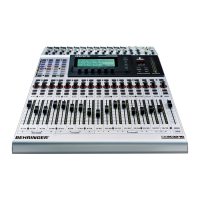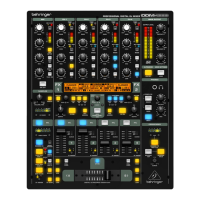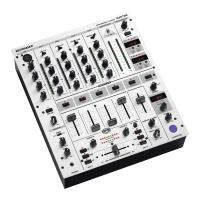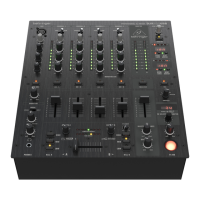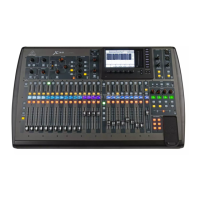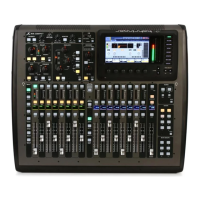36
2. Mixdown: The aux and FX sends are assigned to the outputs
of an I/O module, so as to feed the digital effects devices
with a digital signal provided by the I/O card. Further copies
of the stereo main mix can be routed to the I/O modules for
recording on digital recorders. As an alternative, you can
create a surround mix comprising the stereo main mix and
aux send (or bus) signals, and record this mix to a digital
multi-track recorder.
3. Digital format conversion: If two I/O modules supporting
different digital formats are installed, you can route the
outputs of one card to the inputs of the second, so as to
make digital copies and at the same time convert their digital
formats.
4. Digital router and distribution amplifier: A single signal from
the console can be routed to several outputs arranged in
any order required. Thus, the console software alone
allows you to realize complex patches.
The I/O menu includes two pages for the control of the output
routing: the OUTPUT page provides the routing controls for the
16 outputs of the I/O module, and also controls the dither for
these outputs; on the MODULE page you can determine which
outputs are used by which I/O module.
8.2.3 OUTPUT page in the I/O menu
The OUTPUT page in the I/O menu controls the output routing
and provides the routing controls for the 16 I/O module outputs,
which are assigned in groups of 2. Available signal sources are
the stereo main mix and monitor busses, the 16 mix busses, four
aux and four FX sends as well as all of the 32 input channels.
Fig. 8.3: OUTPUT page in the I/O menu
Master controller 1 (OUTPUT) selects the output to be edited,
and shows the current signal source for the selected output.
Turning or pressing this controller does not change the routing,
but displays the current routing for each single output.
Master controller 2 (SOURCE) selects the signal source for
the selected output. Press or turn this controller to scroll the list
of available signal sources. Any changes made to a signal source
will be displayed on the selected output only after ENTER has
been pressed.
Master controller 3 provides three presets for all 16 I/O module
outputs, so that you can directly connect these outputs to busses
1-16, channels 1-17 or 17-32.
+ The signals for the direct outputs 1-32 are taken
pre-DSP.
Turn the Master controller to select the preset of your choice
(displayed as ”<”). Pressing the controller will transfer the settings
to master controllers 1 and 2. Any changes made to the signal
source routing will take effect only after ENTER has been pressed.
Master controller 4 (DITHER) controls the dither for the output
selected with master controller 1. Dither is a low-level signal
reducing the amount of quantization noise, and should be set to
the word length supported by the connected equipment. Dither
can be set to “OFF” if an exact copy of the input signal is required.
Here, too, it should be noted that ENTER must be pressed before
any changes will be effective.
Master controller 5 controls the dither for all 16 outputs at the
same time. Turn the controller to select the word length of your
choice (“<”), or press it to copy the settings to all outputs. Press
ENTER to finalize the changes.
+ All settings on this page take effect only after ENTER
has been pressed!
Abbreviation Sources
MAIN L-R Main mix
SOLO L-R Solo bus
AUX 1-4
Aux send 1 to 4
(in groups of 2)
FX 1-4
FX send 1 to 4
(in groups of 2)
DI 1-32
Direct outs of channels 1 to 32
(in groups of 2)
BUS 1-16
Bus outs 1 to 16
(in groups of 2)
Tab. 8.2: Available signal sources for the 16 outputs
8.2.4 MODULE page in I/O menu
On the MODULE page in the I/O menu you can assign the
outputs to the optionally available I/O modules.
Fig. 8.4: MODULE page in the I/O menu
Each I/O module is equipped with 8 or 16 outputs. Each group
of 8 outputs can be assigned to the internal outputs 1-8, 9-16, or
MULTI-MR.
I/O outputs 1-16 are dedicated outputs for the I/O modules, to
which almost any mixer signal can be assigned (OUTPUT page
in I/O menu). The default assignment is mix busses 1-16.
MULTI-MR or “Multi Mirror” offers a digital version of the
console’s analog main outputs. Channels 1-4 are digital copies
of the MULTI outputs (default: aux 1-4), channels 5/6 correspond
to the stereo main mix, and channels 7/8 carry the solo bus.
The MODULE page also contains information on the modules
installed, such as type, number of supported channels, and
version.
8.3 Configuring the S/PDIF input and output
8.3.1 S/PDIF page in the I/O menu
Your DDX3216 features a digital audio input based on the
S/PDIF format. This input is fitted with a sample rate converter
that allows you to feed in digital signals with sample rates
between 32 and 50 kHz.
Fig. 8.5: S/PDIF page in the I/O menu
When you enable this input on the S/PDIF page in the I/O menu
(master controller 1), its signal will be routed to channels 13/14.
In this case, the two channels are no longer available for other
internal audio signals.
The digital S/PDIF output provides a copy of the main mix signal.
On the S/PDIF page master controller 5 adjusts the word length
and dither. The noise shaping function, which can be activated
with master controller 6, shifts the dither-generated noise to a
less audible frequency range.
8. INPUT/OUTPUT ROUTING

